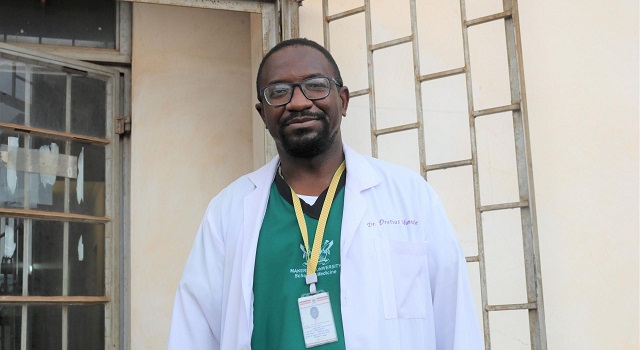
Kampala, Uganda | THE INDEPENDENT | While global research suggests that children with sickle cell disease in Africa are not at risk of getting a stroke, new research by a Mulago hospital based pediatrician shows otherwise.
Dr. Deogratias Munube who has been working at the Mulago Sickle Cell Clinic for more than fifteen years says that currently, about three in every ten children admitted daily in the Acute Care Unit have a stroke.
“The background that many of us have is that stroke is for elderly people afflicted with hypertension, diabetes or a chronic disease,” Dr Munube said during an interview. “However, during my postgraduate studies, I saw many children with sickle cell coming in with stroke and this compelled me to research more about the condition.”
Munube who is also the only specialist handling sickle cell disease-related stroke at the country’s national referral hospital had found in an earlier study conducted in 2016 that the risk of stroke is highest during the first 10 years of one’s life and most prominent between five and 10 years.
Of the 100 children enrolled for the study, 7% suffered a stroke and majority of these had other health complications such as severe anemia, acute bacterial infection and pain crisis at the time of presentation.
“My initial work was to describe children who have sickle cell and how they present with stroke,” he explained. “I found that the commonest presentation was weakness in one part of their body and thus the inability to use that part such as the right upper limb or lower limb.”
This weakness is a result of the stroke blocking an artery that supplies blood to the brain, a condition scientifically called ischemic stroke. Consequently, the blockage reduces blood flow and oxygen to the brain, leading to brain damage.
Other presentations observed include abnormal behavior such as shouting or laughing unnecessarily, inability to respond to a parent’s call, drooling of saliva, drooping of the face and even blindness.
The doctor says that Ischemic stroke, which constitutes 84% of all strokes among sickle cell sufferers, is highest during the first 10 years of life and after 30 years. Inversely, patients may also suffer a stroke that is caused by bleeding on the brain, scientifically called a hemorrhagic stroke. This stroke is common among individuals in their 20’s.
“Children who suffer a stroke often live with the after effects for the rest of their lives,” Munube said. “Strokes usually impair their learning abilities and motor function, requiring a lifetime of physical, occupational and speech therapy.”
To identify factors that predispose children with sickle cell to having stroke, the researcher used an imaging test called a Transcranial Doppler (TCD) to detect factors that affect blood flow in their brains.
“The test revealed that 70% of the 100 children examined had abnormally high blood speed in the brain which indicated narrowed blood vessels. This puts many of them at a high risk of having a stroke,” he explained.
In terms of medical interventions, children who suffer a stroke must undergo frequent blood transfusion which is necessary to prevent recurrences of stroke.
Unless long-term transfusion therapy is provided, 70% to 90% of children who experience a single stroke have subsequent events, according to the researcher.
With recommendations for healthcare workers to keep monitoring children for signs of a stroke risk, Dr. Munube’s research which was supported by the NURTURE Research Training and Mentoring Program for Career Development at Makerere University’s College of Health Sciences shows that a child with sickle cell is 300 times more likely to have a stroke than a healthy child.
With these findings, Munube says the Department of Pediatrics and Child Health plans to introduce TCD screening for their patients which he anticipates might prevent 8,000 new stroke cases per year.
The doctor also urges people planning to start having children to go for a sickle cell screening test to establish whether they have the disease or carry the gene.
For the new born, he says they should be screened even when they look healthy since infants don’t show symptoms at birth because baby hemoglobin protects the red blood cells from becoming sickle shaped.
However, when the infant is around four or five months of age, the baby’s fetal hemoglobin is replaced by sickle hemoglobin and the cells begin to sickle.
According to Ministry of Health statistics, 245,000 babies are born annually with sickle cell disease in Uganda.
*****
URN
 The Independent Uganda: You get the Truth we Pay the Price
The Independent Uganda: You get the Truth we Pay the Price



